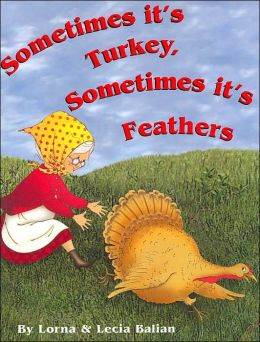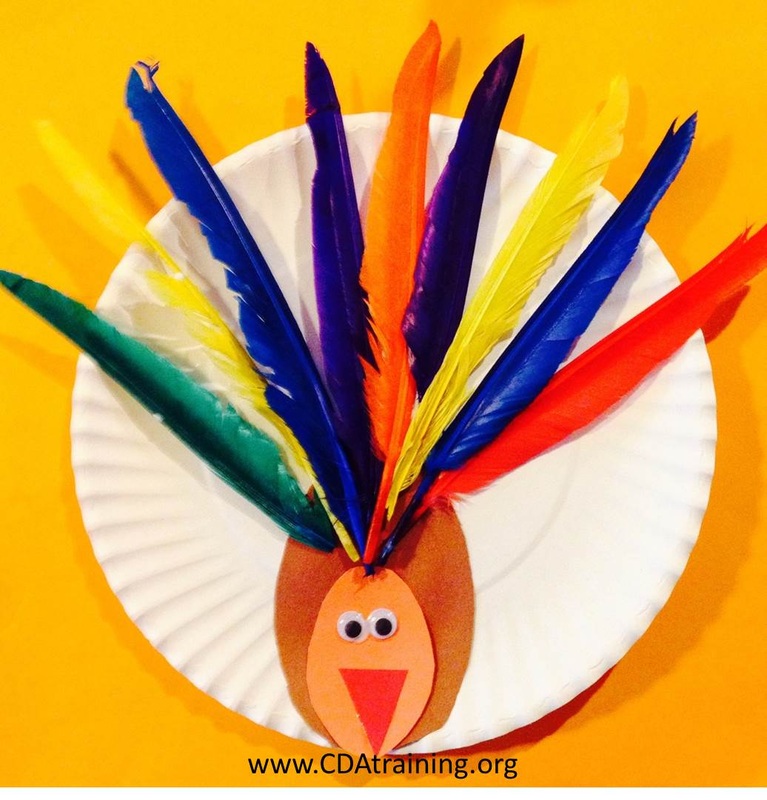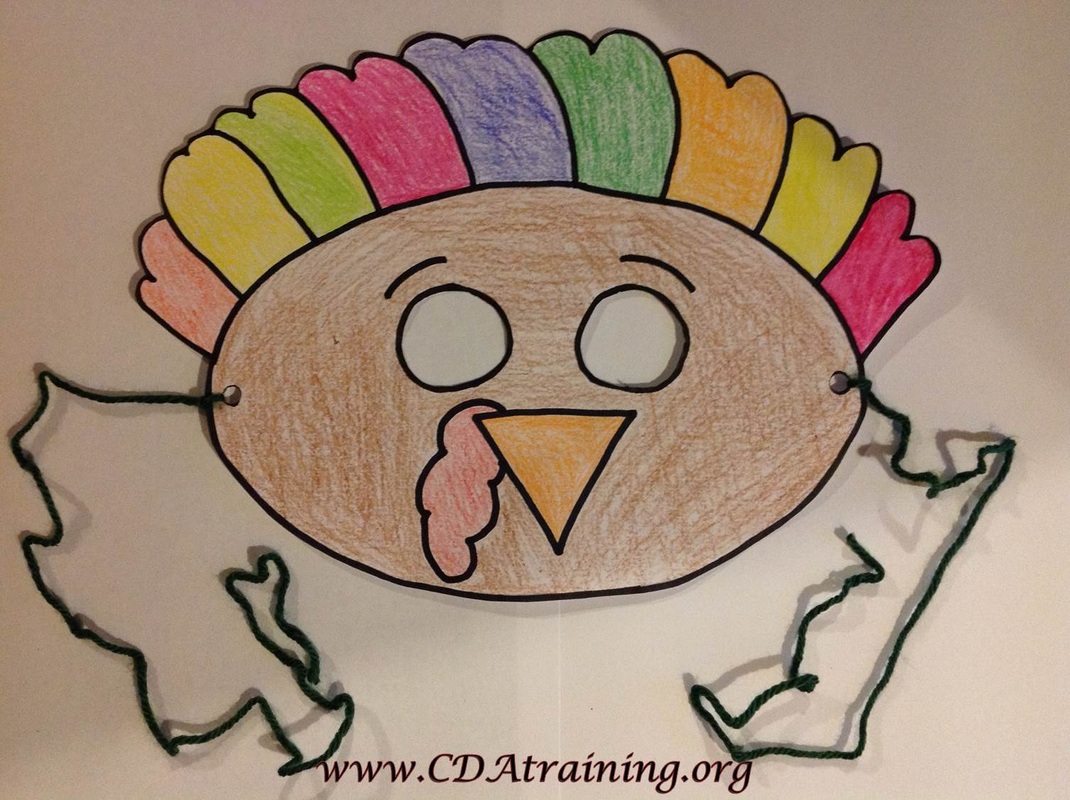|
Read: “Sometimes It’s Turkey, Sometimes It’s Feathers” by Lorna Balian and Lecia Balian Instructions; For fun drop feathers every time Ol’ Tom loses his feathers and let the children pick them up when the game is done. Supplies Needed; Scissors and crayons or markers. Directions; Have children color and cut out "Tom Turkey" and his feathers. As you recite the poem (posted above). Ask the children to drop the feather as you recite the poem. Materials needed: Paper plate, fake feathers, glue, construction paper brown, orange and red construction paper, scissors, and wiggly eyes.
Directions: cut one shape the size of an avocado, one shape the size of an egg, one size the shape of a small triangle for the beak. Put the large shape on the plate in the center-bottom vertical. Put the next size on top of this shape for the gobbler. Put the triangle at the top of the egg size shape for a beak. Put the wiggly eyes near the triangle. Or, let the children use these shapes any way they think is nice. Let the children glue on as many feathers as they think a turkey should have. Supplies Needed; Turkey print out (see below), crayons or markers, and 20 fall colored candies. For our candies we used peanut butter m&m's, but you can easily substitute for candy corn, skittles, gummy bears, raisins or even grapes.
Instructions; Have children color turkey as desired. give them 20 candies and instruct them to place them in the circles (as shown below). For older children, you can ask them to create specific patterns or to add/subtract candies as a math integration activity. Supplies Needed; Print out of mask (below), crayons or markers, hole punch, about 10-12" of yarn and scissors.
Directions; Have children color the mask as they desire. Once finished, assist them in cutting out the eye holes, and assist them in using the hole punch to create holes in the side of the mask (over the black dots). Tie 5-6" of yarn to each hole punch. position the mask on the child's face, and tie the yarn behind their head. Read: “Grateful” A Song of Giving Thanks” by John Bucchino and Anna-Lisa Hakkarainen. Materials needed: a jar, rick-rack, stickers etc., glue, scissors, Chocolate kisses.
Directions: Give each of the children a jar, glue and scissors and decorations. Let them decorate their thankful jar. Send instructions home about how to use the Thankful Jar. Instrctions: Each day have your child name something they are thankful for, and place a chocolate kiss in the jar. Celebrate by eating the thankful kisses on Thanksgiving. Spelling stones are a fun Thanksgiving craft and spelling activity rolled into one. Create a challenge by asking “How many words can we make with the word Thanksgiving?” and use your child’s natural competitiveness as fuel for learning. The stones are a great way to teach letters, and also show children how to interchange letters in a word to create other words. Supplies; stones (dollar store, or foraged stones) , temper paint , a paint brush, paper, and pencil.
Directions; If you use foraged stones, you might need to paint them a solid color. Start by writing out thanksgiving on the stones. We used all uppercase letters so they would be easier to read. We used several layers of temper paint to turn our stones black. These paints are washable so the kids could help, and it was ok if it got on their clothes. Once our primary paint dried, we painted on the letters. We used different colors, and outlined them with a gold art pen. Once dry, lay out the stones on a flat surface. Explain the challenge to the children. How many words can they make with the letters? |
ThanksgivingArchives
November 2014
Categories
All
|
- Blog
- Online Child Care Courses
-
Seasonal Themes
-
Spring Themes
>
- Air and Space
- Arbor Day
- Birds
- Bunnies
- Cinco De Mayo
- Easter
- Eggs
- Farm
- Father's Day
- Fishing
- Flags of the World
- Flowers and Gardening
- Foster Care Awareness Resources
- Found Art
- Hot Air Balloon
- International Children's Book Day
- Insects
- Kid Friendly April Fools Pranks
- Mother's Day
- National Bed Month
- Rainbows
- Saint Patrick's Day
- Spring
- Sports
- Weather
- Women's History Month
- Worms
- Fall Themes >
- Summer Themes >
-
Winter Themes
>
- Advent
- Black History Month
- Cardiac Health
- Christmas >
- Chinese New Year
- Congenital Heart Defect Awareness Month
- Dental Heath Awareness
- Dr. Martin Luther King Jr. Day
- Dr. Seuss Birthday
- Elf on the Shelf Ideas
- Football - Super Bowl
- Germs and Illness
- Grinch
- Groundhog Day
- Hanukkah
- Hibernation
- Kwanzaa
- National Cookie Day
- New Years
- Olympic Games
- Penguin
- Pets
- Post Office
- Presidents Day
- Sensory
- Snow
- Snowman
- Teddy Bears
- Winter
- Valentines Day
- Valentines Day Cards
- Valentines Day Decorations
-
Spring Themes
>
- All About Babies
- Growing and Learning
- Contact Us
- Online Courses for Early Childhood Educators
We have provided links where books or educational items that are related to the lesson plan can be purchased on Amazon. These links are intended for the purpose of your convenience to find the referenced item. However, as an Amazon Associate we earn from qualifying purchases that result from clicking on the links.
This website is owned and managed by Successful Solutions Professional Development LLC. Links to online courses that can be purchased are services that are provided by Successful Solutions Training in Child Development, which is a subsidiary of Successful Solutions Professional Development LLC.
This website is owned and managed by Successful Solutions Professional Development LLC. Links to online courses that can be purchased are services that are provided by Successful Solutions Training in Child Development, which is a subsidiary of Successful Solutions Professional Development LLC.
We offer the most comprehensive student support available in a web based learning environment.
E-mail: [email protected]
Phone: (360) 602-0960
Phone: (360) 602-0960
123 Play-and-Learn! Child Care Basics Resources
A child care curriculum blog brought to you by Successful Solutions Training in Child Development.
A child care curriculum blog brought to you by Successful Solutions Training in Child Development.
Address: PO Box 727, Burley, WA 98322-0727 * www.123playandlearn.com
Copyright 2018. Successful Solutions Professional Development LLC. * All Rights Reserved. Updated June 27, 2018
Copyright 2018. Successful Solutions Professional Development LLC. * All Rights Reserved. Updated June 27, 2018
















 RSS Feed
RSS Feed
